Continuing Education in the Fitness Industry
Continuing education: it can be time consuming, inconvenient, and costly. But it is a very necessary part of any credentialed profession.
Lost your password? Please enter your email address. You will receive a link to create a new password.
Continuing education: it can be time consuming, inconvenient, and costly. But it is a very necessary part of any credentialed profession.

The vertical markets in the health, fitness, recreation and leisure industries are extremely diverse. The question “What vertical should I work in” is not a fair question as many of you will work in several verticals early on in your career. Even as your career progresses, you may shift from one vertical to another as your experience level and personal needs change. Having multiple options is a good thing!
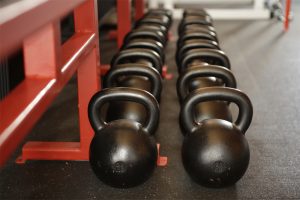 With 50,000 health clubs in the U.S. there are plenty of choices for employment. Within this “vertical” there are numerous sub-categories and options.
With 50,000 health clubs in the U.S. there are plenty of choices for employment. Within this “vertical” there are numerous sub-categories and options.
Benefits of working for a large chain:
Downside of working for a large chain:
There are thousands of non-profit recreation facilities. Most people are familiar with YMCA’s and JCC’s, but there are many others including the Boy and Girls Clubs, scouting organizations and actual hospital-based medical fitness centers, which we will discuss in another segment.
Non-profits often run like for-profit facilities. The difference is they have a non-profit status, which saves them on tax obligations among other things.
Non-profits offer great facilities with community-based programs that are usually well run. They have a similar management structure as traditional multi-purpose health club facility and almost always have a board of directors made up of community leaders. Their disadvantage sometimes is operating capital. This affects employees as you are often undercapitalized for equipment purchases, repairs, payroll and general supplies. At times, you may have to do a combination of management and front-line duties.
Benefits of working for non-profits:
Downside of working for non-profits:
Municipal Park and Recreation Departments provide a variety of opportunities in diverse areas: Full-blown health club-like facilities, Outdoor trail systems/workouts, sports leagues, golf course management, tennis court management, aquatics, water parks, community centers and even marinas.
Park and recreation jobs seem to be more stable than conventional fitness jobs. These jobs can be difficult to get based on the community you live in. Programs and facility operations are sometimes affected by politics and government budgets/cuts.
Benefits of working for Park and Recreation Departments:
A lot of outdoor and recreation based opportunities
Downside of working for Park and Recreation Departments:
Medical or hospital-based fitness centers are an emerging market. There are close to 1,000 medical fitness centers in the U.S. Fully-integrated health and fitness campuses set the stage for a comprehensive medically integrated environment focused on club members’ total well-being, ranging from day-to-day health maintenance, to sports performance training, to cardiac and physical rehabilitation. Most often they have extensive aquatics offerings. Baby boomers and seniors are big supporters of medical fitness centers as the centers almost always have a hospital system as a partner. If you like working with seniors and enjoy medicine, then this would be a great career avenue to explore. The internal management organization looks very similar to an established upscale health club. Often, you will see more medical personnel with office space within the facility.
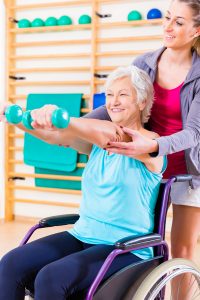 Benefits of working for a medical based fitness center:
Benefits of working for a medical based fitness center:
Downside of working for a medical based fitness center:
Personal Training and Sports Specific-Training Studios are typically smaller and offer more personalized attention than traditional health clubs. One-on-one or small group training has become extremely popular. Customers who patronize these facilities usually don’t care about health club amenities they don’t use, and want to work in a smaller, more personalized setting.
The sports-specific training facilities are great facilities to help athletes get an edge on the competition by maximizing their potential with the exact training protocols based on their season/sport. This type of training also gives young athletes confidence and parents are onboard with supporting their kids in this manner. Employees who work in this environment are usually well educated, have multiple specialized certifications, (not a prerequisite however), and are passionate about working with athletes.
Benefits of working for a personal training/sports specific training site:
Downside of working for a personal training/sports specific training site:
Country clubs and master planned communities provide a very comfortable work environment. These clubs usually have experienced leadership, full service amenities, excellent benefits and provide an environment with less stress than health clubs. In country clubs, you may even get an employee meal each day or major discounts on food and beverage.
This is an emerging market and it is estimated that over 65% of country clubs now have fitness/aquatics and even spas.
Benefits of working for a country club/master planned community:
Downside of working for a country club/master planned community:
Some clubs are run by management companies, so do your homework as some management companies are great to work for, and some are very demanding
Corporate fitness centers are great places to work for getting management experience quickly. Major companies contract out with management companies that specialize in running corporate fitness centers. Some corporations may even run their own centers with in-house management and staff.
If you have a degree in the exercise sciences, have group exercise and personal training certifications and 1-2 years of experience, you would be a great candidate for a site manager in a corporate setting. You would manage a small staff of part-timers and you would be doing it all; from scheduling staff to teaching classes and everything in between.
Benefits of working for a corporate fitness center:
Downside of working for a corporate fitness facility:
Working in the hotel/resort/cruise ship industry has its pluses and minuses. The work environment is typically a beautiful setting. There is a huge number of employees from all over the world, which creates a fun environment. Compensation will vary tremendously with the cruise lines paying the least and expecting the most, regarding the number of hours you work.
Benefits of working for Hotels/Resorts/Cruise Ships
Staff development and customer service training
Downside of working for Hotels/Resorts/Cruise Ships
With the baby boomer population becoming the largest segment of the population, senior living facilities will be employing a variety of fitness and recreation staff for decades to come. There are large regional and national companies that manage facilities across the U.S.
The important thing to consider if considering working in this environment is do you like working with seniors? Have you had much interaction in your past with the aging population? Possibly with grandparents, neighbors, friends of the family or in previous jobs? If you think you are interested in working with seniors you may consider working part-time hours if available to test the waters.
A position in a senior facility may involve running fitness classes, managing group exercise/aquatic instructors and even planning a lot of fun activities and trips.
Benefits of working in senior living facilities:
Almost all colleges and universities have comprehensive fitness, aquatic and recreation facilities. There are numerous opportunities in this arena. While in college, you may have the opportunity to work part-time in a facility to get a feel for this environment.
Many of these facilities are managed by companies that specialize in running college/university recreation complexes. Some schools manage their own facilities. It would be beneficial, to know in advance, who your employer is.
Benefits of working in College/University Fitness and Recreation Facilities:
Excellent healthcare and other benefits usually available through the company or management company
Downside of working for College/University Fitness and Recreation Facilities:

Becoming an owner can be an exciting opportunity in any business, especially in the fitness industry. Most people who become owners have several years of experience in the industry. Others, who are passionate about fitness, become owners after having a successful career in another field.
There are several ways to go about owning a fitness facility:
Your economic position will have a lot to do with which option to pursue. If you have years of experience, but don’t have cash reserves or financing options, then D may become your only option. These arrangements require a lot of due diligence on your part. I have known people who have become wealthy with this arrangement and others who have received nothing for their efforts.
Is a great option if you have had extensive experience with start-ups and grand openings of clubs? You must be properly capitalized to open a new club! Owning real estate also sweetens the payoff.
Buying an existing facility may work if you do your research. Is there a legitimate reason the club is for sale? How is the business performing financially? How are the demographics in the area? Is it a growth area or declining demographic? How old is the facility? Will it require a lot of maintenance dollars to maintain the club? Do your homework.
Buying a club that has just closed could be a great opportunity. Do your due diligence and negotiate the best deal possible with the landlord. Find out who owns the equipment! Landlords often need a club in the retail center they own to drive traffic to other retailers. So, you may be in a good position to negotiate. You also need to find out how dues are being billed, how many members have pre-paid and a host of other financial questions.
Really good franchises require a lot of money upfront. Franchises offer a successful track record and a plan to follow. Research the companies and watch out for a sales environment that is designed to garner “a yes” from everyone they speak to.
Some franchises require specific business skills and do a great job “Qualifying” prospects to see if you meet their qualifications. Other companies qualify you by making sure you have your check book with you. Do your homework.
Benefits of owning your own club:
Downside of owning your own club:
There are management companies in a few of the above verticals: health clubs, colleges/universities, corporate fitness centers and even medical fitness centers.
Really good management companies own and manage their own facilities as well as managing sites. Do your homework and really investigate/research the management company you are going to consider working for.
Benefits of working for Management Companies
Excellent health insurance and benefits usually available
Downside of working for Management Companies:
To see more of articles like this, and receive career tips, job opportunities and more, sign up for the NCCPT Newsletter at https://tinyurl.com/nccptnewsletter
One of the things that sets the NCCPT apart from other organizations is our focus on the business end of fitness. The science is important but equally important is ensuring our trainers have the resources to help them succeed. To help with everything from a job search and interview to asking for raise the NCCPT is proud to partner with Alan Cohen, President of fitnessjobs.com and a life time industry expert.
Article reprinted with permission from NCCPT. Written by Alan Cohen. Alan is a career expert in the health & fitness industry and founder of FitnessJobs.com. He can be reached by email at alan@fitnessjobs.com or by calling 800-259-4397.
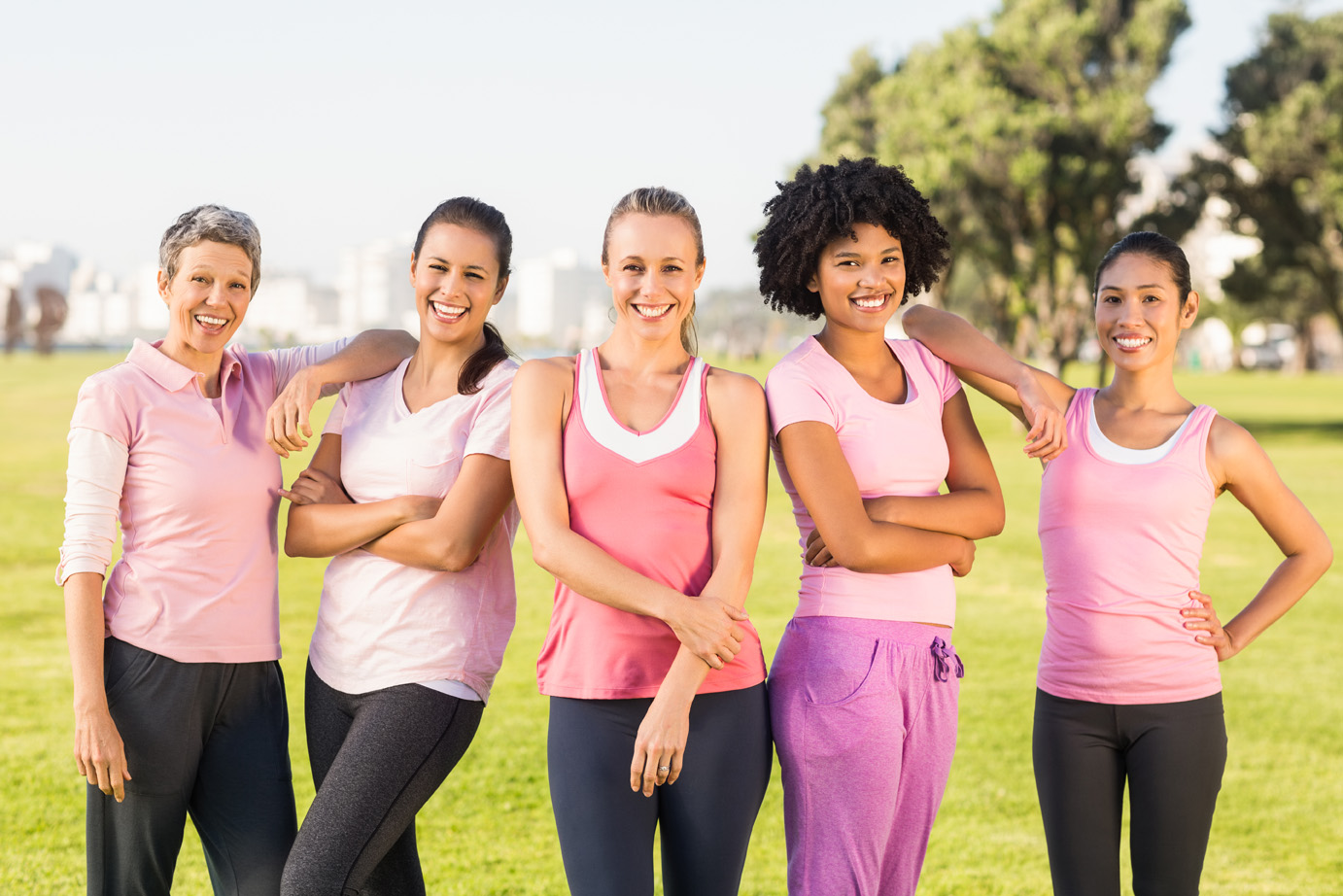
Do you know any breast cancer survivors? What if you were told that exercise could help them get their lives back? Would you want to learn more?
 There are 3 million breast cancer survivors in the United States today. Survivorship is considered to be from the time that one is first diagnosed to many years later. Fitness professionals are uniquely positioned to help survivors regain control over their mind and body through a well thought out, systematic and progressive exercise program.
There are 3 million breast cancer survivors in the United States today. Survivorship is considered to be from the time that one is first diagnosed to many years later. Fitness professionals are uniquely positioned to help survivors regain control over their mind and body through a well thought out, systematic and progressive exercise program.
There are many women who live with metastatic disease. This is breast cancer that has spread to other organs and is the most serious diagnosis. Breast cancer survivors undergo different treatments depending on the stage of their breast cancer.
The stages are organized from 1-4 with stage 1 being the least serious and stage 4 being cancer that has spread to other organs. The treatments can include surgery, radiation, and systemic treatments. Systemic treatment affects the entire body and includes chemotherapy and biological and hormonal treatments. In addition, surgery to replace the breast is another option performed either at the time of surgery or later on.
In addition, the treatments can vary from one individual to another as there are many different treatment protocols which one can choose from in coordination with the medical team. Access to treatment facilities can be another factor in treatment options.
Unfortunately, breast cancer treatment can wreck havoc physically, cognitively, emotionally and spiritually. Some of the challenges that survivors face are chemotherapy Induced peripheral neuropathy, fatigue (most common), osteoporosis, chemotherapy related cognitive dysfunction, pain, weight gain, cardio toxicity and decreased balance.
A medical fitness trainer can provide survivors with a safe well- balanced exercise program that supports healing from treatments, side effects, treatment precautions, and contraindications.
Naomi Aaronson MA OTR/L CHT, CPI, Certified Cancer Exercise Trainer, has been an occupational therapist for 20 years and a certified hand therapist for 10 years. Naomi was introduced to Pilates after two car accidents, and credits Pilates for restoring both her strength and spirit. She is a well known author and presenter who believes in the power of mind and body to foster healing.
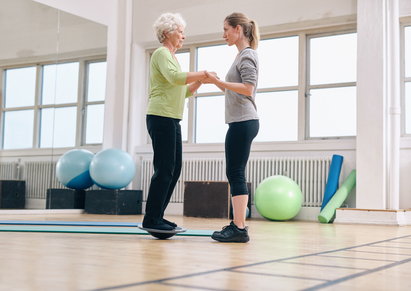
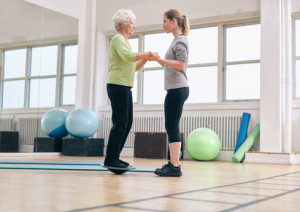 Challenges with balance and stability can happen to all of us as we get older, but is certainly more prevalent in our Parkinson’s community. Maintaining lower body strength in conjunction with balance is very important as it decreases one’s chances of falling. Balance is defines as the state of having your weight spread equally so you do not fall; stability is the quality or state of something that is not easily moved. In order to maintain balance and stability, we need to have our center of gravity over a strong base of support. If your center of gravity standing upright is the area of your belly button – then your feet are your base of support. Standing with both feet on the ground spread just past shoulder width offers a stronger base of support than standing on one leg or with your feet very close together.
Challenges with balance and stability can happen to all of us as we get older, but is certainly more prevalent in our Parkinson’s community. Maintaining lower body strength in conjunction with balance is very important as it decreases one’s chances of falling. Balance is defines as the state of having your weight spread equally so you do not fall; stability is the quality or state of something that is not easily moved. In order to maintain balance and stability, we need to have our center of gravity over a strong base of support. If your center of gravity standing upright is the area of your belly button – then your feet are your base of support. Standing with both feet on the ground spread just past shoulder width offers a stronger base of support than standing on one leg or with your feet very close together.
There are many issues that can affect your ability to balance yourself while standing or walking. Trouble with vision, lack of lower body strength, poor posture, medications, low blood pressure, and inability to properly lift our feet are all contributors. So how can you better prepare yourself to stay strong on your feet?
Slow Rise: When standing up from a chair or rising out of bed – do so slowly and wait about 5 seconds before you begin to walk. This enables your body to adjust to the change of position.
Hands Free: Keep at least one hand free at all times while walking – carrying an object with both hands can interfere with your ability to balance.
Arm Swing: Attempt to swing both arms from front to back while walking – this also helps maintain an upright posture and reduces fatigue.
Walk Consciously: Always strive to consciously lift your feet off the ground while walking; a shuffling gait can cause one to trip.
Make a U-Turn: When trying to navigate a turn while walking, use a “U” technique of facing forward and making a wide turn as opposed to pivoting sharply.
Helping Aides: Don’t be intimidated by canes, walking sticks, walkers or grab bars. These helpful devices can keep you safe and prevent a fall.
Keep it Simple: Only do one thing at a time when you are on your feet. Using a phone, gazing around, or even drinking a beverage can be a distraction and affect your balance.
In addition to taking these steps to maintain your balance and stability – take precautions in your home to make it safe. Loose throw rugs, scurrying pets, wet bathtubs and slippery staircases can cause danger in your home and throw even the most strong and stable person off balance. Also, working with a fitness professional to strengthen your stomach and leg muscles will help keep you more stable and lessen your likelihood of falling if you were to lose your balance. A strong body is a more stable body!
Carisa Campanella, BA, AS, is an ACE Health Coach and ACSM Personal Trainer. She is the Program Manager at the Neuro Challenge Foundation for Parkinson’s. Neuro Challenge provides ongoing monthly support groups and educational programs, individualized care advising and community resource referrals to help empower people with Parkinson’s and their caregivers.

 Your body was built to move but to move effectively and efficiently, especially over the long haul, it needs to rest. At any given point in time a significant percentage of competitive athletes and even fitness buffs are over-trained. The “overtraining syndrome” is brought on by athletes falling into the ‘too much, too hard, too frequent and too little rest’ mode. Usually done to improve performance, but ultimately resulting in a point of diminishing returns- or gains actually turned to losses. Common symptoms can include all of some of the following: fatigue, irritability, muscle soreness, difficulty sleeping, elevated resting heart rate, decline in performance and even the onset of overuse injuries.
Your body was built to move but to move effectively and efficiently, especially over the long haul, it needs to rest. At any given point in time a significant percentage of competitive athletes and even fitness buffs are over-trained. The “overtraining syndrome” is brought on by athletes falling into the ‘too much, too hard, too frequent and too little rest’ mode. Usually done to improve performance, but ultimately resulting in a point of diminishing returns- or gains actually turned to losses. Common symptoms can include all of some of the following: fatigue, irritability, muscle soreness, difficulty sleeping, elevated resting heart rate, decline in performance and even the onset of overuse injuries.
Exercise and the training associated with it, are a very powerful stimulus. Your body is challenged on multiple levels, from individual body parts to the system as a whole. For example, if you do a typical weight training session, each muscle that you work is stimulated and there is a local response in that muscle. There is also a cumulative metabolic cost to your entire system from that workout. This is true also of any vigorous workout including running, cycling and swimming. Local body parts are challenged as is the entire system. Your body needs to recover from both, and each has its own timetable.
To make gains – either muscle growth with weight training or cardiovascular with aerobic exercise – you need the exercise stimulus (ideally a near maximal effort) followed by adequate rest and recovery. It is on that rest stop where gains are actually made, as the body repairs itself, adapts, and you are taken to the next level. It should be clear why the mindset of “if a little is good, more is better” does not work here. It is also why smart successful professional and high performance athletes schedule recovery time as they would a workout, practice or a training session. It is critical to optimal performance. In fact, in recent years, we have made such tremendous gains in the areas of training and nutrition, that we may be reaching the point of maximum benefit for those variables. I believe that recovery is the next frontier in optimal training and achieving peak performance.
Also recovery doesn’t mean you need to be on the coach doing nothing. There are forms of “active rest” that can actually enhance and speed recovery. Take a walk or do a very light aerobic activity. Blood-flow to the nooks and crannies of the body enhances recovery and the repair process. Also, try yoga, get a massage, or hit the whirlpool. Water is a great medium for recovery, so hit the pool and try some light movements like treading water. But think twice before taking the ice plunge as recent research suggests that ice baths may delay or interfere with the recovery process. Drinking plenty of water and eating properly are also critical. The timing of your nutrition is also important, especially after a hard workout, as there is a golden 30-60 minute post-workout window where certain nutrients can make a recovery difference. Chocolate milk is one nearly perfect choice. And never underestimate the power of getting adequate shut-eye. The body repairs itself mentally and physically during sleep. I recently saw a funny but astute tweet (by Shower Thoughts @TheWeirdWorld) that said, “your bed is pretty much just a charger for your body.”
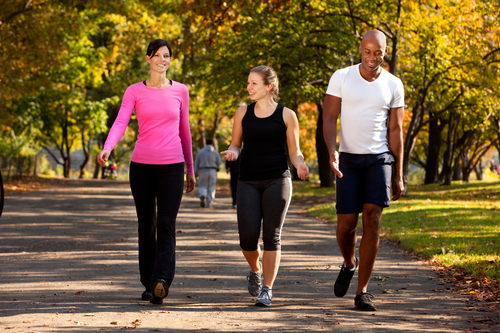 When it comes to the body’s adaptability and recovery response, the key is not pounding your body the same way everyday. Also follow the 10% rule-never increase your program (i.e. the amount of weight lifted or miles logged) more than 10% per week. This especially true when coming off an injury. Trying to make up for lost time courts disaster. Increasing the intensity, duration or frequency of your workouts too rapidly can interfere with your body’s amazing ability to adapt, resulting in overtraining, injury or both. Also there are new technologies like the Marc Pro device that can enhance muscle recovery and it is no surprise that so many professional and high level athletes are using it regularly. For those aging athletes and Master’s athletes, remember that the body does not recover as efficiently as we age, so you may need a little longer time to bounce back.
When it comes to the body’s adaptability and recovery response, the key is not pounding your body the same way everyday. Also follow the 10% rule-never increase your program (i.e. the amount of weight lifted or miles logged) more than 10% per week. This especially true when coming off an injury. Trying to make up for lost time courts disaster. Increasing the intensity, duration or frequency of your workouts too rapidly can interfere with your body’s amazing ability to adapt, resulting in overtraining, injury or both. Also there are new technologies like the Marc Pro device that can enhance muscle recovery and it is no surprise that so many professional and high level athletes are using it regularly. For those aging athletes and Master’s athletes, remember that the body does not recover as efficiently as we age, so you may need a little longer time to bounce back.
Remember what Lau Tzu said many years ago, “a bow that is stretched to its fullest capacity may certainly snap”. In your effort to constantly improve your fitness or specific sports skills you are probably at times pushing yourself to that very brink. Be aware of that predictable time of vulnerability for you, one that is usually remedied by a little R&R thrown into the mix.
So, for optimal gains, in the gym or on the field, learn to kick back at times. Give yourself a break – you will comeback even stronger.
Originally published on the Huffington Post. Reprinted with permission from Dr. DiNubile.
Nicholas DiNubile, MD is an Orthopedic Surgeon, Sports Medicine Doc, Team Physician & Best Selling Author. He is dedicated to keeping you healthy in body, mind & spirit. Follow him MD on Twitter: twitter.com/drnickUSA
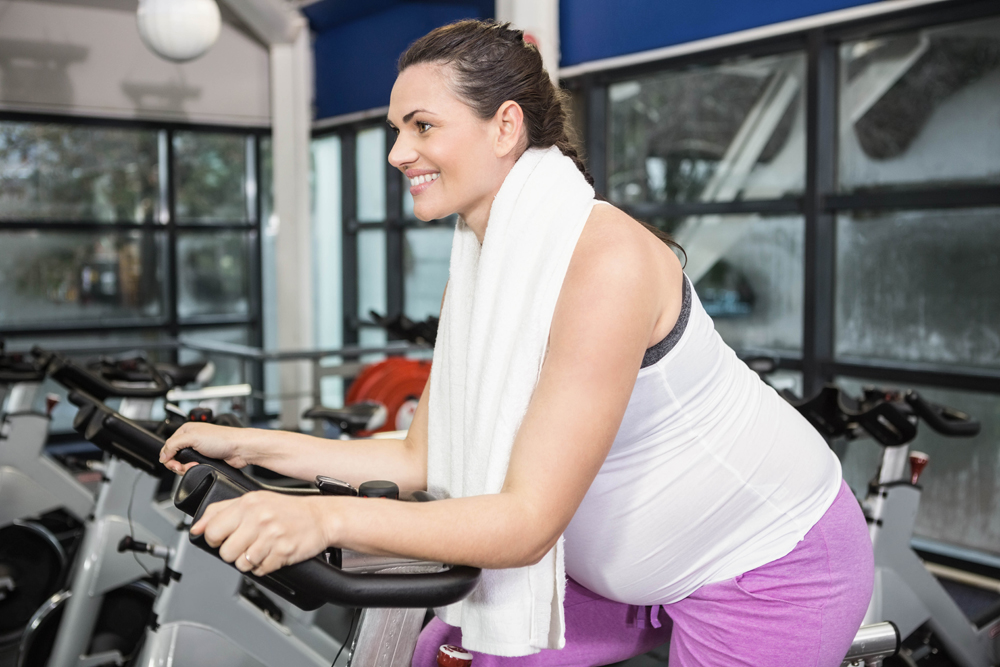
Choosing the type of exercise that is best tolerated during pregnancy depends on the following considerations:
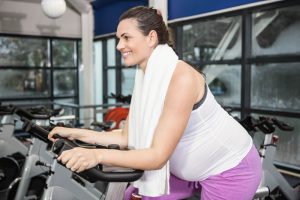 Weight-bearing exercise such as walking, dancing, and running help maintain bone mass and some studies suggest they are more effective for keeping pregnancy weight gain within normal limits. As pregnancy progresses some women may not be able to continue weight-bearing exercise because of back or round ligament pain. If modifications such as wearing a belly support don’t relieve discomfort, switching to non-weight-bearing activities such as swimming, stationary biking, or other types of stationary exercise equipment is recommended.
Weight-bearing exercise such as walking, dancing, and running help maintain bone mass and some studies suggest they are more effective for keeping pregnancy weight gain within normal limits. As pregnancy progresses some women may not be able to continue weight-bearing exercise because of back or round ligament pain. If modifications such as wearing a belly support don’t relieve discomfort, switching to non-weight-bearing activities such as swimming, stationary biking, or other types of stationary exercise equipment is recommended.
Absolute and relative contraindicated activities for pregnant women are listed below. Pregnant women should always consult with their healthcare provider before taking part in any exercise program and assess the risk/benefit ratio whenever there is a question about the safety of any activity during pregnancy. Keep in mind that activities such as downhill skiing must be assessed for risks that are not controllable, such as the effect of high altitude on oxygen delivery to the fetus.
Contraindicated Activities for Pregnant Women
You can also view Catherine’s previous articles on exercise intensity and duration.
For more information on prenatal and postpartum exercise and our CE correspondence course, “Prenatal and Postpartum Exercise Design” please visit, www.ppfconsulting.com
Article reprinted from Catherine’s Maternal Fitness blog with permission.
Catherine Cram, MS, is the owner of Comprehensive Fitness Consulting, a company that provides pre- and postnatal fitness certifications and information to hospitals, health & wellness organizations and the military.
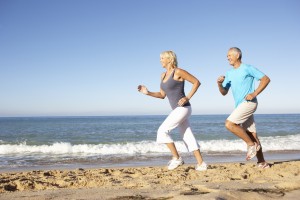
 Feeling too grumpy or stressed out to exercise? Think again.
Feeling too grumpy or stressed out to exercise? Think again.
A little exercise can go a long way in reducing stress and making you feel good, along with its many other health benefits, like improving/maintaining physical fitness, preventing disease and treating symptoms.
Life is complicated. We are all busy with our own personal challenges and to-do lists. Not to mention the winter months, which can make even the hardiest New Englander want to curl up into a ball and stay in bed until spring finally arrives. But, as tempting as that sounds, it’s not likely to improve your mood at all. If you’re feeling down, resist the urge to mope and get moving.
Studies have shown that moderate to intense exercise can help…
For those interested in the science behind it, when your body is subjected to certain stimuli (including exercise) your hypothalamus calls for the release of endorphins, and the cells in your body that contain them respond. When endorphins lock into special receptor cells, they block the transmission of pain signals and also produce feelings of euphoria. But endorphins can’t do it alone…. exercise also raises levels of other mood-boosting chemicals like serotonin, dopamine and norepinephrine. The combination of endorphins and these other neurotransmitters produces and effect often referred to as “the runners high”.
In reflecting back on my time as a distance runner, I remember saying many times that it wasn’t always the act of running that got me out there day after day – but rather, the tremendous feeling that I got after my run that had such a positive impact on my outlook. But you don’t have to be a runner to enjoy the benefit of the runners high….just 30 minutes of physical activity can elicit this effect on the body and improve our mood on a chemical level.
 How else can it affect us?
How else can it affect us?During a fast-paced tennis match or an intense kickboxing class, you’ll find that you concentrate more on your body’s movements than on the things that are irritating you or stressing you out. Redirecting your focus can help calm and clear your mind. This is referred to as “Active Relaxation” or the capacity to focus on rhythmic motion that can produce a relaxation response within the body.
By reducing our levels of stress, anxiety and depression, we can also sleep better at night, thus improving our energy during our awake hours and reducing irritability and depression often associated with inadequate sleep. How to get started? Consult your doctor or an exercise professional if you’re new to exercise or have health concerns. Safety first! Start with small, manageable goals and choose an activity that you enjoy. Exercise shouldn’t feel like a chore. Then make room in your schedule! Make your health a priority and set aside time each day to focus on you. You’ll be glad you did.
Jaclyn Chadbourne, MA is a Clinical Exercise Physiologist and Principal, Director of Research and Development – Universal Medical Technology, LLC and United Medical Gym, Inc in South Portland, ME. With a passion for sustainable healthy living and desire to advocate for patient-centered care, Jaclyn works to help support community resources for all special populations and to implement and oversee clinical protocols.
References
http://www.nbcnews.com/id/18043835/ns/health-fitness/t/getting-high-exercise/#.UwJ-wvldXtI
http://www.mayoclinic.org/healthy-living/stress-management/in-depth/exercise-and-stress/art-20044469
http://www.webmd.com/fitness-exercise/features/runners-high-is-it-for-real
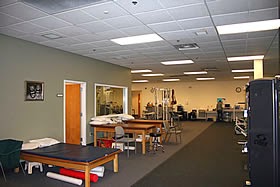
Before I was diagnosed with MS, and for the first few years afterward, I was dedicated to my exercise programs. My ideal workout time was early morning, because all I had to do was wake up, get my feet on the floor, and lean forward. The next thing I knew I was at the gym.
After my MS diagnosis, I continued to visit the gym on a regular basis. Eventually, when my legs became too weak, I had to give up on the aerobic exercise and the lower body weight lifting. But I still maintained my upper body workouts – even when I started using a cane, two forearm crutches, and then a scooter. Finally, it became too much, and I stopped going to the gym in 2006.
 Fast-forward to 2013. My neurologist told me about a facility in South Portland called the Medically Oriented Gym, or MOG. Saco Bay Physical Therapy works one-on-one with patients like me at the MOG. In September, I had my first appointment with Gabe, a physical therapist. We talked about goals. I wanted to maintain or improve the range of motion and strength in my upper extremities. Also, I would welcome anything they could do for leg strength and flexibility, but I knew that would be a more difficult task.
Fast-forward to 2013. My neurologist told me about a facility in South Portland called the Medically Oriented Gym, or MOG. Saco Bay Physical Therapy works one-on-one with patients like me at the MOG. In September, I had my first appointment with Gabe, a physical therapist. We talked about goals. I wanted to maintain or improve the range of motion and strength in my upper extremities. Also, I would welcome anything they could do for leg strength and flexibility, but I knew that would be a more difficult task.
Gabe measured my strength and range of motion to establish a baseline. He then worked with his associate, Jodi, to develop a program for me. Over the past nine months Jodi has incorporated a variety of stretching routines and exercises to strengthen specific muscles and maintain or improve my flexibility. Gabe has evaluated my progress on a regular basis. I have at least maintained and even improved in some of his measures. It’s a beautiful thing.
Gabe, Jodi, and the rest of the team are consummate professionals. Not only do they understand the mobility issues I’m facing, but they exhibit sincere empathy. They know when to push me hard and when to back off. They constantly come up with creative new ways to challenge my muscles to do anything and everything they are still able to do.
I generally have two one-hour sessions per week, and I plan to keep this up indefinitely. In my case, insurance is picking up 100% of the costs.
The benefits I experience from my workouts at the MOG are more than physical. There is an emotional component as well. I always feel more positive about my life when I am fighting back against this creeping paralysis. And even in the days before I became disabled, I experienced a boost from my gym workouts if for no other reason than I was getting out of the house and moving around. That still applies.
 This physical therapy program isn’t going to overcome the relentless attack that MS is waging on my central nervous system. My overall physical well-being is continuing to deteriorate, and I don’t expect it to stop. But the work I am doing at the MOG allows me to maintain as much strength and flexibility as I possibly can, for as long as I possibly can. I encourage everyone with MS or other similar conditions to “use it or lose it.” If you live in the greater Portland area, I recommend Saco Bay Physical Therapy and the MOG. If you live elsewhere, find a physical therapist and a gym that you can work with.
This physical therapy program isn’t going to overcome the relentless attack that MS is waging on my central nervous system. My overall physical well-being is continuing to deteriorate, and I don’t expect it to stop. But the work I am doing at the MOG allows me to maintain as much strength and flexibility as I possibly can, for as long as I possibly can. I encourage everyone with MS or other similar conditions to “use it or lose it.” If you live in the greater Portland area, I recommend Saco Bay Physical Therapy and the MOG. If you live elsewhere, find a physical therapist and a gym that you can work with.
If you’re a healthy person, and you’re not getting regular exercise, are you just trying to piss me off? You enjoy such good fortune, yet you do nothing to nurture and protect it. Don’t make me come over there and kick you in the ass, because I will.
One of the exercises Jodi has me do is to lie on my back (which is no small feat) and execute bench presses. Before MS, I could do three sets of ten with a substantial weight on the bar. I would grunt and strain and put everything I had into each repetition. When working with free weights, I always had a spotter, because if the weight were to land on my chest or neck it could have been dangerous. But today I am bench pressing a broomstick, and I still grunt and strain and put everything I have into each repetition. Last week I said to Jodi, “You better stay here and spot me, because if I get pinned by this broomstick I’m not sure I’ll be able to breathe.”
We laughed and laughed. I’m a funny guy.
Read more from Mitch at his blog, Enjoying the Ride.
Learn more about the MOG on their website.
“Still a Gym Rat” From Enjoying the Ride
Copyright Mitch Sturgeon, May 2014

No one looks forward to the day when they need to have a joint replaced. It can seem intimidating, and for good reason. Many patients can have a fairly extensive recovery period with some never regaining full use of the joint in question. But this doesn’t have to be the case. If they prepare properly, they can avoid a great deal of pain and frustration from recovery.
Every year in the United States, there are over 600,000 knee replacement surgeries alone. Hip and knee replacements are very common in those suffering from osteoarthritis, and they are in need of a critical professional — personal trainers.
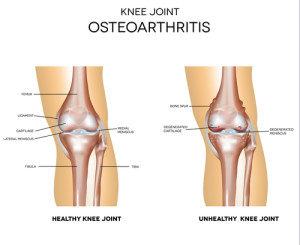 Osteoarthritis primarily affects older adults over 50. As opposed to most millennials today, this generation of adults didn’t grow up with exercise being a regular part of life. As such, there is a high degree of sedentary people who also suffer from osteoarthritis and needing joint replacement.
Osteoarthritis primarily affects older adults over 50. As opposed to most millennials today, this generation of adults didn’t grow up with exercise being a regular part of life. As such, there is a high degree of sedentary people who also suffer from osteoarthritis and needing joint replacement.
The research is pretty clear — those who are more physically fit have fewer complications in surgery and, above all, require significantly less time to recover afterward. The problem is that a significant portion of this population do not exercise and do not know how to do so safely. Thus, the special skillsets that personal trainers have are incredibly valuable to them.
For most people facing joint replacement, there is a two-fold objective: weight reduction and muscle strengthening. This is because the less the patient weighs, the less pressure is placed on the recovering joint. Furthermore, the stronger the supporting muscles are around the rest of the body, the better-able the patient is to regain mobility.
As such, the training program should include:
Above all, the key to training these clients is SAFETY FIRST. These clients are already suffering from joint pain, and excessive training can make the situation that much worse.
The population of older adults suffering from osteoarthritis and needing joint replacement is on the rise. It’s estimated that in 20 years, there will be as many as 4 million procedures a year. There is a definitive need for personal trainers who know enough about osteoarthritis and joints in the body to make a difference in these patients’ lives. Word of mouth referrals from successful outcomes are a likely possibility and the opportunity to collaborate with healthcare professionals is extensive.
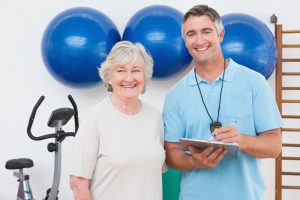 I have worked with Dr. Irv Rubenstein to put together a course like none other that will get personal trainers up to speed as quickly as possible on the essentials. We go over what happens in the joints and how they deteriorate as well as what happens during and after joint replacement surgery.
I have worked with Dr. Irv Rubenstein to put together a course like none other that will get personal trainers up to speed as quickly as possible on the essentials. We go over what happens in the joints and how they deteriorate as well as what happens during and after joint replacement surgery.
In this course, you will learn:
Most importantly, we discuss what is safe and effective for this clientele as well as what to avoid at all costs — exercises which increase the likelihood of injury and exacerbation of pain. We look forward to empowering personal trainers to use their skills and expertise to benefit older communities that they wouldn’t normally think about when looking for new clients. This is a population in desperate need of a personal trainer’s ability, especially in the delicate days before surgery and continued work with the client once their physical therapy time has ended.
Jane Curth is the co-founder and CEO of FitFixNow. Helping people on their wellness journey is her passion; Jane has helped clients and students with their diet and fitness struggles for over 20 years.